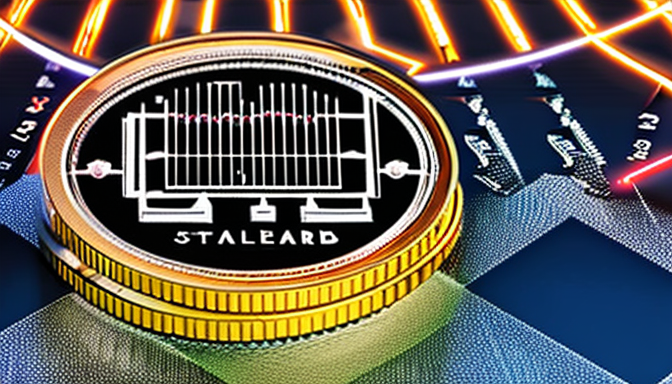Stablecoins have emerged as a crucial asset in the ever-evolving landscape of the cryptocurrency market, acting as a stabilizing force amidst the rampant volatility that characterizes digital currencies. Unlike traditional cryptocurrencies like Bitcoin or Ethereum, which often experience dramatic price swings, stablecoins aim to maintain a consistent value, typically pegged to a fiat currency or a basket of assets. This unique characteristic allows them to serve as a reliable medium of exchange and a safe haven for investors during turbulent times.
To understand the significance of stablecoins, it is essential to explore their underlying structure. Most stablecoins are designed to be collateralized, meaning they are backed by reserves of assets. These assets can be traditional currencies, other cryptocurrencies, or even commodities. The primary purpose of stablecoins is to mitigate risk and provide liquidity in the cryptocurrency ecosystem, enabling users to transact without the fear of sudden value loss.
There are three main categories of stablecoins: fiat-collateralized, crypto-collateralized, and algorithmic. Each type employs different mechanisms to achieve stability:
- Fiat-Collateralized Stablecoins: These are backed by fiat currencies like the US dollar. Examples include Tether (USDT) and USD Coin (USDC), which maintain their value through reserves held in secure accounts. Transparency in these reserves is crucial for user confidence.
- Crypto-Collateralized Stablecoins: These stablecoins utilize other cryptocurrencies as collateral. While they provide an alternative to fiat-backed stablecoins, their value can be subject to the same volatility as the underlying assets.
- Algorithmic Stablecoins: Rather than being backed by assets, these stablecoins use algorithms to control supply and demand, aiming to keep their value stable. However, their effectiveness can vary, as seen in the case of TerraUSD.
The adoption of stablecoins has surged in recent years, particularly in decentralized finance (DeFi) applications. Their ability to facilitate transactions without the volatility associated with traditional cryptocurrencies has made them a preferred choice for traders and investors alike. Furthermore, stablecoins play a pivotal role in remittances and as a means of preserving value during market downturns.
As stablecoins continue to gain traction, they are increasingly coming under the scrutiny of regulatory bodies worldwide. The implications of regulations could significantly affect their operation, stability, and future growth. It is essential for stakeholders to remain informed about these developments to navigate the changing landscape effectively.
Looking ahead, the integration of stablecoins with Central Bank Digital Currencies (CBDCs) presents exciting opportunities. This potential collaboration could redefine financial systems, offering enhanced efficiency and accessibility. However, challenges remain, including regulatory hurdles and the need for market confidence.
In conclusion, stablecoins represent a vital innovation in the cryptocurrency market, providing a necessary balance between the inherent volatility of digital assets and the desire for stability. As the landscape evolves, their role will likely expand, influencing both decentralized finance and traditional financial systems.

Understanding Stablecoins
is essential for grasping their role within the broader cryptocurrency ecosystem. Stablecoins represent a category of digital currencies specifically designed to maintain a stable value, often through a peg to a reserve of assets such as fiat currencies or commodities. This stability is crucial in a market characterized by significant volatility, providing users with a reliable means of transaction and a store of value.
Stablecoins can be broadly categorized into three types: fiat-collateralized, crypto-collateralized, and algorithmic. Each type employs distinct mechanisms to maintain price stability, catering to various use cases within the financial landscape.
- Fiat-Collateralized Stablecoins: These stablecoins are backed by reserves of traditional currencies, such as the US dollar. Examples include Tether (USDT) and USD Coin (USDC). They typically maintain a 1:1 peg to their underlying fiat currency, ensuring that each stablecoin is redeemable for a corresponding amount of fiat. The reserves are usually held in bank accounts and are subject to audits to ensure transparency and trust.
- Crypto-Collateralized Stablecoins: Unlike fiat-backed stablecoins, these use other cryptocurrencies as collateral. For instance, DAI is a well-known example that utilizes Ethereum as collateral. While they offer decentralization, they also carry risks associated with the volatility of the underlying assets, which can lead to liquidation if the collateral value falls below a certain threshold.
- Algorithmic Stablecoins: These do not rely on collateral but instead use algorithms to control the supply of the stablecoin in response to market demand. An example is TerraUSD, which aimed to maintain its peg through a dual-token system. However, such systems can be vulnerable to market dynamics and have faced criticism for their sustainability.
Understanding the mechanisms behind stablecoins is crucial for users and investors alike. The transparency of reserves, regulatory compliance, and the operational frameworks of these currencies significantly influence their adoption and trustworthiness. For instance, fiat-collateralized stablecoins often undergo regular audits, enhancing their credibility.
As stablecoins continue to evolve, their integration into various sectors, including decentralized finance (DeFi), remittances, and trading, highlights their growing importance. Research indicates that stablecoins can mitigate risks during market downturns, providing a safe haven for investors seeking to preserve value amidst volatility.
In conclusion, stablecoins serve as a bridge between traditional finance and the burgeoning world of cryptocurrencies. Their structured approach to maintaining value not only facilitates transactions but also fosters greater confidence among users navigating the complexities of the crypto market. As the landscape continues to evolve, ongoing research and regulatory developments will play a pivotal role in shaping the future of stablecoins.

Types of Stablecoins
Stablecoins represent a significant innovation in the cryptocurrency landscape, designed to mitigate the inherent volatility that characterizes most digital assets. These coins are categorized based on their underlying mechanisms of value stability, primarily into three types: fiat-collateralized, crypto-collateralized, and algorithmic stablecoins. Each category employs distinct strategies to maintain their peg, influencing their adoption and usability in various financial contexts.
Fiat-Collateralized Stablecoins are perhaps the most straightforward in their structure. Backed by traditional fiat currencies, such as the US dollar or the Euro, these stablecoins maintain a 1:1 value ratio with their underlying asset. Prominent examples include Tether (USDT) and USD Coin (USDC). To ensure trust, issuers typically hold reserves in bank accounts or similar secure assets, which are regularly audited to provide transparency. According to a report by the Financial Stability Board, such reserves must be readily accessible to guarantee that every issued token can be redeemed for its equivalent fiat value.
In contrast, crypto-collateralized stablecoins utilize other cryptocurrencies as collateral. This approach introduces a layer of complexity, as the value of the collateral can fluctuate significantly. For example, Dai, a popular crypto-collateralized stablecoin, is backed by Ethereum and operates through smart contracts on the Ethereum blockchain. While this model allows for decentralization, it also comes with risks, as a sudden drop in the value of collateral can lead to liquidation events, potentially destabilizing the stablecoin’s value.
Algorithmic stablecoins employ a different mechanism altogether. Instead of being backed by collateral, they rely on algorithms to control the supply of the stablecoin in response to market demand. This category includes projects like TerraUSD, which faced significant challenges in maintaining its peg during market downturns. The failure of TerraUSD highlighted the fragility of algorithmic models, raising questions about their long-term viability in the face of market stress.
Each type of stablecoin serves specific use cases within the broader cryptocurrency ecosystem. For instance, fiat-collateralized stablecoins are commonly used for trading on exchanges, remittances, and as a safe haven during market volatility. On the other hand, crypto-collateralized stablecoins appeal to users who prefer decentralized finance (DeFi) platforms, where they can leverage their crypto assets without converting them into fiat. Algorithmic stablecoins, while still experimental, aim to provide a more flexible monetary policy, although their adoption remains cautious due to past failures.
In conclusion, understanding the different types of stablecoins is crucial for navigating the evolving cryptocurrency landscape. Each category presents unique advantages and challenges, influencing their role in financial transactions and investment strategies. As the market matures, ongoing research and regulatory scrutiny will likely shape the future of these digital assets, ensuring they can fulfill their intended purpose of providing stability in a volatile environment.
Fiat-Collateralized Stablecoins
are an essential component of the cryptocurrency market, providing a reliable means of transacting in a volatile environment. These stablecoins are directly pegged to traditional fiat currencies, particularly the US dollar, which helps to mitigate the price fluctuations often seen in other cryptocurrencies. The most well-known examples of fiat-collateralized stablecoins include Tether (USDT) and USD Coin (USDC), each with distinct operational frameworks that enhance their utility.
Tether (USDT) was one of the first stablecoins introduced to the market, aiming to bridge the gap between fiat currencies and cryptocurrencies. It is designed to maintain a 1:1 peg with the US dollar, meaning that for every USDT issued, there should be one US dollar held in reserve. However, Tether has faced scrutiny regarding its transparency and the actual reserves backing the coin. In 2021, Tether published a breakdown of its reserves, revealing that a significant portion was held in commercial paper and other short-term investments rather than cash, raising concerns about its liquidity during market downturns.
USD Coin (USDC), on the other hand, was launched by Circle and Coinbase as a more transparent alternative to Tether. USDC is also pegged to the US dollar, and its reserves are regularly audited by a third-party firm, ensuring that each USDC in circulation is backed by one US dollar held in a bank account. This level of transparency has garnered trust among users and has led to its growing adoption in various sectors, including decentralized finance (DeFi) and remittances.
Both USDT and USDC serve critical roles in the crypto ecosystem, enabling users to quickly convert volatile cryptocurrencies into stable assets. This function is particularly vital during market downturns, where traders can seek refuge in stablecoins to protect their investments. Moreover, these stablecoins facilitate seamless transactions on exchanges, allowing users to move in and out of positions without the need for traditional banking systems.
In summary, fiat-collateralized stablecoins like Tether and USD Coin are pivotal in maintaining stability within the cryptocurrency market. Their operational frameworks, transparency measures, and the trust they have established among users contribute significantly to their utility and adoption. As the market continues to evolve, the role of these stablecoins will likely expand, influencing both trading practices and the broader financial landscape.
Mechanisms of Value Maintenance
Stablecoins, particularly fiat-collateralized ones, play a crucial role in the cryptocurrency ecosystem by providing a stable value through reserves held in traditional financial assets. These reserves are typically composed of cash or cash-equivalents, such as bank deposits or government securities, which are maintained in secure accounts. The mechanisms of value maintenance for these stablecoins are essential for understanding their reliability and trustworthiness in a volatile market.
To ensure that stablecoins, like Tether (USDT) and USD Coin (USDC), maintain their peg to the US dollar, issuers must regularly audit their reserves. This process involves independent third-party verification, which confirms that the amount of fiat currency held in reserve matches the total supply of the stablecoin in circulation. For instance, USDC is backed by a 1:1 ratio with US dollars, and Circle, the issuer, undergoes monthly attestations by a reputable auditing firm. Such transparency is vital for building consumer confidence and regulatory compliance.
Moreover, the regulatory landscape surrounding stablecoins is evolving rapidly. Regulatory bodies across various jurisdictions are increasingly scrutinizing the mechanisms that underpin these digital currencies. This includes examining how reserves are managed and ensuring they are not subject to excessive risk. For example, the Financial Stability Oversight Council (FSOC) in the United States has expressed concerns regarding the potential systemic risks posed by stablecoins, emphasizing the need for robust regulatory frameworks to govern their issuance and operation.
- Transparency: Regular audits and disclosures on reserve holdings are critical for consumer trust.
- Regulatory Compliance: Adherence to local and international regulations helps mitigate risks associated with stablecoins.
- Market Confidence: A stablecoin that can demonstrate its ability to maintain its peg is more likely to gain widespread adoption.
In addition to audits, many stablecoin issuers are adopting blockchain technology to enhance transparency. By leveraging decentralized ledgers, they can provide real-time visibility into reserve balances, allowing users to verify the backing of their tokens at any moment. This innovation not only bolsters trust among users but also aligns with the principles of decentralization that underpin the broader cryptocurrency movement.
In conclusion, the mechanisms of value maintenance for fiat-collateralized stablecoins hinge on strict reserve management, regular audits, and regulatory compliance. As the market for stablecoins continues to grow, these factors will be pivotal in determining their long-term viability and acceptance in both the crypto and traditional financial landscapes.
Use Cases and Adoption
Fiat-collateralized stablecoins have become pivotal in the evolving landscape of digital finance, offering a reliable alternative for users seeking stability amidst the inherent volatility of cryptocurrencies. Their backing by traditional fiat currencies, such as the US dollar, provides a level of assurance that is crucial for various financial activities. This has led to their increasing adoption across multiple sectors, including trading, remittances, and as a refuge during economic downturns.
In the realm of trading, fiat-collateralized stablecoins serve as a bridge between the traditional financial system and the cryptocurrency market. Traders utilize these stablecoins to minimize risk exposure while maintaining liquidity. For instance, during periods of high volatility, traders can convert their assets into stablecoins to preserve value without exiting the market entirely. This strategy not only safeguards investments but also facilitates quick re-entry into positions when market conditions improve.
Moreover, in the context of remittances, fiat-collateralized stablecoins offer a cost-effective solution for cross-border transactions. Traditional remittance services often impose high fees and unfavorable exchange rates, but stablecoins can significantly reduce these costs. According to a study by the World Bank, the average cost of sending remittances globally stands at around 6.5%. However, using stablecoins can lower this fee to less than 1%, making them an attractive option for migrant workers sending money home.
During market downturns, many investors turn to fiat-collateralized stablecoins as a safe haven. The stability provided by these coins allows investors to hedge against market fluctuations. For instance, during the market crash in March 2020, many investors flocked to stablecoins like Tether (USDT) and USD Coin (USDC) to safeguard their assets. This trend underscores the role of stablecoins as a reliable store of value, particularly in uncertain economic conditions.
The growing adoption of fiat-collateralized stablecoins is also evident in their integration within various decentralized finance (DeFi) platforms. These platforms leverage stablecoins for lending, borrowing, and yield farming, further enhancing their utility and appeal. As a result, the demand for stablecoins continues to rise, prompting innovations and improvements in their underlying technologies.
In conclusion, the increasing utilization of fiat-collateralized stablecoins for trading, remittances, and as a safe haven during market volatility highlights their importance in the modern financial ecosystem. Their ability to provide stability and liquidity makes them indispensable tools for both individual users and institutional investors alike.
Crypto-Collateralized Stablecoins
represent a unique segment of the stablecoin market, leveraging the inherent value of other cryptocurrencies as collateral to maintain their stability. Unlike fiat-collateralized stablecoins, which are backed by traditional currencies, crypto-collateralized stablecoins rely on the volatility and liquidity of digital assets. This section delves into their operational mechanisms, the risks they entail, and the implications for investors and the broader cryptocurrency ecosystem.
These stablecoins operate through a process known as over-collateralization. For instance, a crypto-collateralized stablecoin may require users to deposit cryptocurrencies worth 150% of the stablecoin they wish to mint. This excess collateral acts as a buffer against market volatility, ensuring that even if the value of the collateral decreases, the stablecoin remains pegged to its intended value. One prominent example is DAI, which is backed by a diversified basket of cryptocurrencies and maintained through smart contracts on the Ethereum blockchain.
However, the reliance on cryptocurrencies introduces significant risks. The primary concern is the volatility of the collateral. If the value of the underlying assets drops sharply, it can trigger a liquidation event, where the collateral is sold off to cover the stablecoin’s value. This scenario can lead to rapid price fluctuations and loss of confidence among users. For instance, during market downturns, the value of collateral can plummet, resulting in a cascade of liquidations that can destabilize the entire system.
Moreover, the complexity of smart contracts used in these stablecoins raises additional concerns. Bugs or vulnerabilities in the code can be exploited, leading to significant financial losses. A case in point is the incident involving the crypto-collateralized stablecoin BitUSD, which faced challenges due to smart contract vulnerabilities, leading to user distrust and a decline in its market presence.
Despite these risks, crypto-collateralized stablecoins offer unique advantages. They provide users with the ability to engage in decentralized finance (DeFi) applications while maintaining exposure to cryptocurrency markets. Additionally, they can facilitate loans and yield farming opportunities, creating a dynamic financial ecosystem. As the technology matures, improved risk management strategies and enhanced transparency are expected to bolster confidence in these stablecoins.
In conclusion, while crypto-collateralized stablecoins present innovative solutions within the cryptocurrency landscape, they are not without their challenges. Understanding the mechanisms, risks, and potential rewards associated with these digital assets is crucial for investors and users alike. As the market evolves, ongoing research and development will be essential to mitigate risks and enhance the stability of these financial instruments.

Algorithmic Stablecoins
Algorithmic stablecoins represent an innovative approach to achieving price stability in the volatile cryptocurrency market. Unlike their fiat or crypto-collateralized counterparts, which rely on physical assets to maintain their value, algorithmic stablecoins utilize complex algorithms and smart contracts to dynamically adjust their supply based on market demand. This mechanism aims to create a self-regulating system that can respond to price fluctuations in real-time.
The design of algorithmic stablecoins typically involves a dual-token system. One token is the stablecoin itself, which is intended to maintain a stable value, while the other token serves as a volatile counterpart that absorbs price shocks. For instance, when the price of the stablecoin rises above its target value, the protocol incentivizes the creation of new stablecoins, effectively increasing supply to bring the price back down. Conversely, if the stablecoin’s price drops, the system encourages users to burn stablecoins, thereby reducing supply and stabilizing the price. This balance between supply and demand is crucial for the effective functioning of algorithmic stablecoins.
One of the most notable examples of an algorithmic stablecoin is TerraUSD (UST), which gained significant attention during its operational period. TerraUSD aimed to maintain its peg to the US dollar through a mechanism involving its sister token, LUNA. However, the collapse of the Terra ecosystem in May 2022 raised critical questions about the sustainability and reliability of algorithmic stablecoins. The rapid de-pegging of UST from the dollar highlighted the vulnerabilities inherent in relying solely on algorithmic adjustments without collateral backing.
Research indicates that while algorithmic stablecoins offer a fascinating alternative to traditional stablecoin models, they are not without risks. The lack of collateral means that during periods of extreme market volatility, these stablecoins can experience significant price deviations from their intended value. A study published in the Journal of Financial Stability suggests that the failure of algorithmic stablecoins often stems from inadequate liquidity and the inability of the algorithm to respond effectively to sudden market changes.
Despite these challenges, algorithmic stablecoins continue to attract interest from developers and investors alike. The potential for creating a decentralized financial system that operates independently of traditional banking systems is appealing, especially in regions with unstable currencies. As the market matures, ongoing research and development are essential to improve the mechanisms that govern these stablecoins, ensuring they can withstand the pressures of real-world application.
In conclusion, while algorithmic stablecoins present an innovative solution to achieving price stability, their design and real-world performance must be carefully evaluated. The lessons learned from past failures can guide future developments, helping to create more resilient and reliable stablecoin systems.
Case Studies: Successes and Failures
Algorithmic stablecoins represent a fascinating yet complex segment of the cryptocurrency landscape, relying on sophisticated mechanisms to maintain price stability without direct collateral backing. Unlike their fiat or crypto-collateralized counterparts, algorithmic stablecoins use algorithms and smart contracts to regulate supply and demand, aiming to ensure that their value remains stable even amidst market volatility.
One of the most notable examples of an algorithmic stablecoin is TerraUSD (UST), which sought to maintain its peg to the US dollar through an innovative dual-token system. TerraUSD was paired with a native token called LUNA, which played a crucial role in the stabilization process. When the price of UST fell below one dollar, the algorithm incentivized users to burn LUNA to mint new UST, effectively reducing supply and pushing the price back up. Conversely, if UST’s price rose above one dollar, users could mint LUNA by burning UST, increasing supply and stabilizing the price.
Despite its promising design, TerraUSD faced significant challenges that culminated in its collapse in May 2022. The failure to maintain its peg during a broader market downturn triggered a massive sell-off, leading to a death spiral where the value of both UST and LUNA plummeted. This event highlighted the vulnerabilities inherent in algorithmic stablecoins, particularly their reliance on market confidence and the effectiveness of their underlying mechanisms.
Research indicates that algorithmic stablecoins can be susceptible to extreme market conditions, as evidenced by the TerraUSD case. A study published in the Journal of Financial Stability examined the mechanisms of various algorithmic stablecoins and concluded that while they offer innovative solutions for stability, they also introduce risks that can lead to systemic failures. The authors emphasized the importance of robust governance frameworks and transparency to enhance trust and confidence among users.
Furthermore, the regulatory landscape surrounding stablecoins is evolving, with authorities increasingly scrutinizing their operational frameworks. The collapse of TerraUSD prompted discussions among regulators about the need for clearer guidelines and standards to protect investors and ensure market stability. As a result, algorithmic stablecoins may face stricter regulations in the future, which could influence their design and adoption.
In summary, while algorithmic stablecoins like TerraUSD present innovative approaches to achieving price stability, their vulnerabilities during market fluctuations cannot be overlooked. The lessons learned from the TerraUSD experience underscore the need for ongoing research and development in this area, as well as the importance of regulatory oversight to safeguard the interests of users and the broader financial ecosystem.
Regulatory Considerations
As stablecoins continue to gain popularity in the financial landscape, regulatory bodies are increasingly focusing on their frameworks and implications. This scrutiny arises from the need to ensure consumer protection, financial stability, and the integrity of the financial system. The regulatory landscape for stablecoins is complex and varies significantly across jurisdictions, reflecting differing priorities and concerns.
Stablecoins, by their nature, are designed to provide a stable value, often pegged to fiat currencies or other assets. However, their growing adoption has raised questions regarding their transparency, liquidity, and risk management practices. For instance, the Financial Stability Board (FSB) has emphasized the need for a comprehensive regulatory framework that addresses potential risks associated with stablecoins, including their impact on monetary policy and financial stability.
One of the primary concerns is the backing assets of fiat-collateralized stablecoins. Regulatory bodies are advocating for stringent requirements regarding the reserves held by these stablecoins. For example, Tether (USDT) and USD Coin (USDC) have faced scrutiny over their claims about reserve backing. In response, some issuers have begun to publish regular audits to enhance transparency and build trust among users. Such measures are vital as they provide assurance that stablecoins are genuinely backed by the assets they claim.
The implications of regulatory frameworks extend beyond just compliance; they also influence the market dynamics of stablecoins. Regulations can affect the liquidity and usability of stablecoins across various platforms. For instance, if certain stablecoins are classified as securities, they may face additional compliance burdens that could limit their adoption in decentralized finance (DeFi) applications.
- Consumer Protection: Regulations aim to protect consumers from potential losses associated with stablecoin investments.
- Financial Stability: Regulatory oversight helps mitigate systemic risks that could arise from widespread stablecoin usage.
- Market Integrity: Establishing clear guidelines can help prevent fraud and enhance overall market integrity.
Moreover, the advent of Central Bank Digital Currencies (CBDCs) has further complicated the regulatory landscape. As central banks explore the issuance of their own digital currencies, the relationship between stablecoins and CBDCs will likely evolve. Regulatory bodies must consider how these two forms of digital money can coexist while ensuring financial stability and consumer protection.
In conclusion, the ongoing regulatory scrutiny of stablecoins is a crucial development in the financial landscape. As these digital assets continue to gain traction, effective regulations will be essential in ensuring their stability and safeguarding the interests of users. The future of stablecoins will ultimately depend on the balance between innovation and regulatory compliance.

The Future of Stablecoins
As the landscape of digital currencies continues to evolve, stablecoins are emerging as a pivotal element in both decentralized finance (DeFi) and traditional financial systems. These cryptocurrencies are designed to maintain a stable value, making them essential for users navigating the inherent volatility of the crypto market. In this context, stablecoins are not just a refuge from price fluctuations; they are becoming integral to various financial applications.
Stablecoins can be categorized into three main types: fiat-collateralized, crypto-collateralized, and algorithmic. Each category has unique characteristics and mechanisms that dictate their stability and use cases. For instance, fiat-collateralized stablecoins like Tether (USDT) and USD Coin (USDC) are backed by reserves of traditional currencies. This backing provides a level of trust and reliability, crucial for users seeking stability in their transactions.
Research indicates that fiat-collateralized stablecoins are increasingly being adopted for various purposes, including trading, remittances, and as a safe haven during turbulent market conditions. A 2023 study by the Cambridge Centre for Alternative Finance highlights that the market capitalization of these stablecoins has surged, reflecting their growing acceptance among both retail and institutional investors.
On the other hand, crypto-collateralized stablecoins utilize other cryptocurrencies as collateral. While they offer the potential for decentralization, they also carry significant risks due to the volatility of the underlying assets. For example, the MakerDAO platform uses Ethereum as collateral, leading to fluctuations that can impact the stability of its DAI stablecoin.
Algorithmic stablecoins, which maintain their value through supply and demand dynamics rather than collateral, present a different set of challenges. The collapse of TerraUSD in 2022 serves as a cautionary tale, illustrating the risks associated with relying solely on algorithmic mechanisms for value maintenance. This incident has prompted regulators to scrutinize these models more closely, emphasizing the need for robust frameworks to ensure stability.
Looking ahead, the integration of stablecoins with Central Bank Digital Currencies (CBDCs) could reshape the financial landscape. A 2023 report by the Bank for International Settlements suggests that stablecoins and CBDCs may coexist, with stablecoins providing a bridge between traditional finance and the innovative potential of digital currencies.
However, the future of stablecoins is not without challenges. Regulatory hurdles remain a significant concern, as governments worldwide seek to implement frameworks that ensure consumer protection and financial stability. Despite these challenges, opportunities for growth and innovation abound, particularly in the realms of cross-border payments and financial inclusion.
In conclusion, as stablecoins continue to evolve, they will play an increasingly vital role in both DeFi and traditional finance. Their ability to provide stability in a volatile market, coupled with potential regulatory advancements, positions them as a key component in the future of digital finance.
Integration with Central Bank Digital Currencies (CBDCs)
The integration of stablecoins with Central Bank Digital Currencies (CBDCs) presents a transformative opportunity for the financial landscape. As digital currencies gain traction, understanding their interplay becomes crucial for policymakers, financial institutions, and consumers alike. The potential for these two entities to coexist and complement each other could lead to a more resilient and efficient financial system.
Stablecoins, which are designed to maintain a stable value, often peg their worth to traditional assets like fiat currencies. This stability makes them attractive for everyday transactions, especially in a volatile crypto market. Meanwhile, CBDCs, issued by central banks, promise to enhance monetary policy effectiveness and provide a secure digital alternative to cash. Together, they could create a hybrid financial ecosystem that leverages the strengths of both systems.
For instance, stablecoins can facilitate cross-border payments with lower fees and faster transaction times compared to traditional banking systems. According to a study by the Bank for International Settlements, integrating stablecoins with CBDCs could streamline these processes further by providing a stable medium of exchange that central banks can regulate. This would not only enhance efficiency but also increase consumer confidence in digital transactions.
Moreover, stablecoins can serve as a bridge to the broader cryptocurrency market, allowing users to convert their digital assets into a stable form of currency before moving to CBDCs. This interoperability could encourage more individuals to engage with digital currencies, thus promoting financial inclusion. A report from the International Monetary Fund highlights that a combined approach could lead to greater adoption rates among unbanked populations, who may find stablecoins more accessible than traditional banking services.
However, challenges remain. Regulatory frameworks need to evolve to address the unique risks associated with stablecoins, such as potential market manipulation and lack of transparency regarding their reserves. A comprehensive regulatory approach could ensure that stablecoins operate within a secure environment while still allowing for innovation. The European Central Bank has initiated discussions on establishing guidelines that could govern the interaction between CBDCs and stablecoins, emphasizing the need for a balanced regulatory framework.
In conclusion, the integration of stablecoins and CBDCs holds significant promise for reshaping financial systems globally. By fostering cooperation between these two digital currency forms, we can enhance transaction efficiency, promote financial inclusion, and ensure a more stable economic environment. As research continues to unfold, stakeholders must remain vigilant in addressing the regulatory and operational challenges that accompany this evolution.
Challenges and Opportunities
Stablecoins are increasingly recognized for their potential to provide stability in the unpredictable cryptocurrency landscape. However, they are not without their challenges. One of the most significant hurdles is the regulatory environment. Governments and financial authorities globally are grappling with how to classify and regulate stablecoins. This uncertainty can create a lack of confidence among users and investors, leading to hesitancy in adoption.
For instance, recent discussions in the European Union have focused on establishing a regulatory framework that ensures consumer protection while fostering innovation. The Markets in Crypto-Assets Regulation (MiCA), proposed by the European Commission, aims to create a comprehensive legal framework for cryptocurrencies, including stablecoins. However, the impact of such regulations on the market remains to be seen, with potential implications for liquidity and operational frameworks.
Another challenge facing stablecoins is their dependence on underlying assets. For fiat-collateralized stablecoins, the requirement to maintain reserves in traditional currencies can lead to liquidity constraints. In times of economic uncertainty, if users rush to redeem their stablecoins for fiat currency, it could trigger a liquidity crisis for the issuer. This scenario was observed during the market turmoil in March 2020, when Tether faced scrutiny over its reserve backing.
Despite these challenges, there are numerous opportunities for growth within the stablecoin sector. The increasing integration of stablecoins into decentralized finance (DeFi) platforms provides a pathway for broader adoption. By facilitating seamless transactions and lending processes, stablecoins can enhance the efficiency of financial services. According to a report by the McKinsey Global Institute, the DeFi sector could grow significantly, with stablecoins playing a pivotal role.
Moreover, the potential collaboration between stablecoins and Central Bank Digital Currencies (CBDCs) presents a unique opportunity. As central banks explore digital currency frameworks, stablecoins could serve as a bridge between traditional finance and the digital economy. This synergy could enhance transaction speeds and reduce costs, benefiting consumers and businesses alike.
In conclusion, while stablecoins face notable challenges such as regulatory scrutiny and market confidence issues, they also present exciting opportunities for innovation and growth. By navigating these complexities, stablecoins can solidify their role as a cornerstone of the evolving financial landscape.
- Key Challenges:
- Regulatory uncertainty
- Liquidity constraints
- Market confidence issues
- Opportunities:
- Integration with DeFi platforms
- Collaboration with CBDCs
- Enhanced transaction efficiency
By addressing these challenges and leveraging opportunities, the stablecoin market can evolve into a robust and reliable component of the global financial ecosystem.
Frequently Asked Questions
- What are stablecoins?
Stablecoins are a type of cryptocurrency designed to maintain a stable value by being pegged to a reserve of assets, such as traditional currencies or commodities. They provide a safe harbor in the often turbulent waters of the crypto market.
- How do fiat-collateralized stablecoins work?
Fiat-collateralized stablecoins are backed by traditional currencies like the US dollar. For every stablecoin issued, an equivalent amount of the fiat currency is held in reserve, ensuring that the stablecoin maintains its value.
- What are the risks associated with crypto-collateralized stablecoins?
Crypto-collateralized stablecoins are backed by other cryptocurrencies, which can be highly volatile. This volatility can lead to situations where the collateral may not cover the issued stablecoins, potentially causing loss of value.
- What are algorithmic stablecoins?
Algorithmic stablecoins aim to maintain their value through supply and demand mechanisms rather than being backed by collateral. They use algorithms to adjust the supply of the stablecoin based on market conditions, which can sometimes lead to instability.
- How are stablecoins regulated?
As stablecoins gain popularity, regulatory bodies are increasingly scrutinizing their frameworks. Regulations can impact their operational structures, transparency, and overall stability, shaping the future of stablecoins in the market.
- What is the future of stablecoins?
The future of stablecoins looks promising as they integrate more with decentralized finance (DeFi) and traditional finance. Emerging trends and innovations, such as their relationship with Central Bank Digital Currencies (CBDCs), could redefine financial systems.














